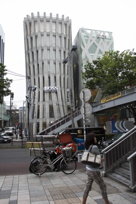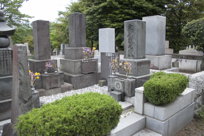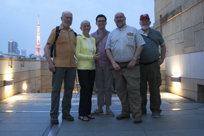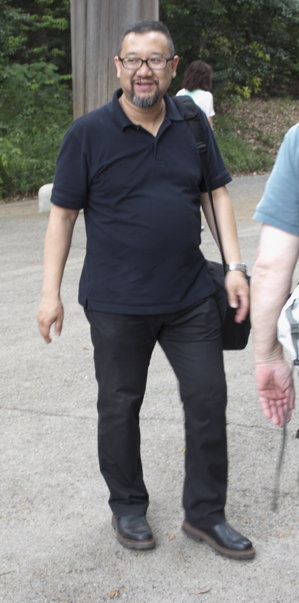
|
|
Just about the only adequate picture of John Tran that I got |
Tuesday, 20 May: First full day of touristing
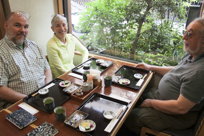
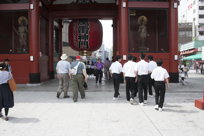
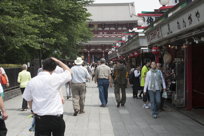
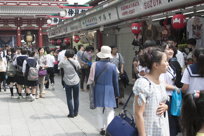
At our ryokan, we were asked when we checked in whether we would like a Japanese breakfast the next day (today) or a Western-style. Japanese, of course! In the upper-left picture in the block to the left, the three oldsters are eagerly awaiting the surprises of the morning (big image, small). In the upper right, we’re out walking, back at the Kaminarimon gate (big image, small). You can identify Mark by the fashionably slouched Tilley hat, Mike by the red baseball cap.
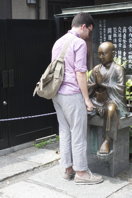
Cindy is visible in the lower left picture, wearing pale yellow; in both pictures of that row, we’re walking in the very much open market, along with multitudes of other people. (Left: big image, small; right: big image, small.)
By the Sensōji there’s a bronze statue of a monk, which is supposed to confer healing on whatever part of you needs help: just give a good rub to the corresponding part of the statue. I forget which part of the monk Mason rubbed (big image, small), but I did the ears. Haven’t noticed any improvement.
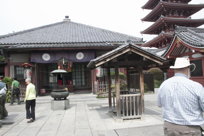
Alongside the Sensōji Temple is the Asakusa Shrine, a Shinto building devoted to the three men who founded the Sensōji. It’s one of the few old buildings in Tōkyō that was not destroyed during WW II, so the Japanese consider it to be of special cultural importance. You can see it to the right (big image, small), unfortunatey not a very flattering picture.
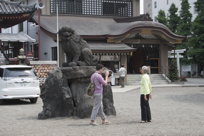

Mark and I did feel, most uncharitably, that Mason wanted to get a good look at every temple or shrine that we passed. But we figure that he’s an art-history guy, so he’s entitled. The two pictures to the left show us at a shrine that we passsed by just a few minutes after leaving the Asakusa Shrine. (Upper image: big, small; lower: big, small). Please note the dog statue that appears in both. I almost said “statue of a dog”, but it’s clearly no such thing, it seems to me, being not dependent on any actual dog anatomy but rather on artistic convention. Chinese? I must ask Mason.
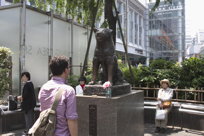
Speaking of dogs, an acquaintance of Mike’s makes special dog biscuits. She asked Mike to make sure that one of her products was offered to the statue of Hachikō, an Akita of 80 years ago or so, who waited at the train station for his dead master every day at the time the train came in, for nine years. Mason, who is very good at this, made the proper signs of piety before laying the biscuit before the statue. (Big image, small.)
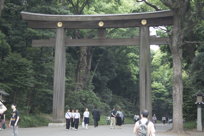
We did lot of walking this day, and along the way on one of our walks was the entrance to the Meiji Shrine, marked by the impressively large Torii gate that you see to the right. We didn’t go in at this time, but we would, later in the day. (Big image, small.)
Our appointment with John Tran was to be at three, and Mike had information about a special restaurant in the same neighborhood as our rendezvous. So this was the target of the current walk. Unfortunately, we never did find that restaurant, so settled for another, which satisfied our needs perfectly well. (These needs consisted in most cases of Beer, sometimes of More Beer, and usually of food.)
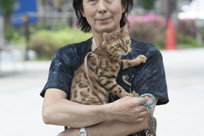
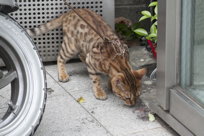
After eating, we still had time to kill, so we stood at our meeting spot across from a train station. And there there stood a youngish man with a scooter, this being augmented with a small-animal carrier lashed to the buddy seat. And he had on a leash the most amazingly-marked cat, which you see to the left. Sometimes the cat was in his arms (big image, small), sometimes the cat ranged as freely as the leash allowed (big image, small). I thought that it wouldn’t have been strange for the man to have a little cup to receive donations for the upkeep of this beautiful creature, but there was no such thing in evidence. After some time, the cat allowed itself to be placed into the carrier, and they sputtered off.
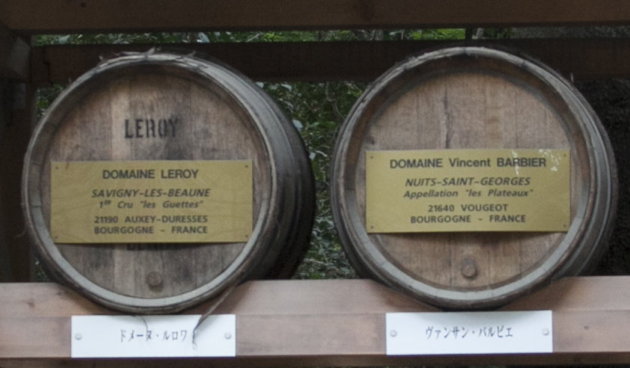
|
|
Just two of the casks of wine in the array on
the ceremonial avenue leading to the Meiji Shrine. |
John Tran is a photographer who also writes for the Japan Times. This day, though, his function was as docent for an architectural tour of Tokyo that Mark had arranged through Context Travel. Mark and I had benefited from several Context tours in Italy, so with coordination with Mike, Mark set this tour up.
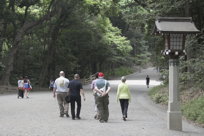
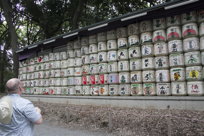
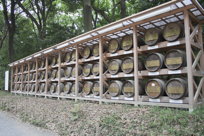
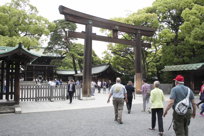
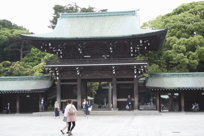
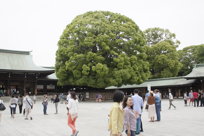
Throughout our walk, John emphasized the tension in Japanese culture between the desire for an authentic Japanese-ness, and the desire to be “modern”, perhaps even “western”. As you might expect, Mason ate this all up, but all of us found the discussions very illuminating.
We started the tour at the Meiji Shrine, passing through the big wooden torii depicted a few paragraphs up, and continued along the broad avenue leading to the Shrine proper (block of pictures to the right, top left: big image, small). Along the way were banks of, first, straw-covered sake-barrels (top right: big image, small) and then, wine-casks (second row left: big image, small), all offered to the Shrine by various sake brewers or vintners. I didn’t check all the barrels, but the two you see in the big picture above were both Burgundies.
The righthand picture in the middle row shows us entering into the precinct of the Shrine (big image, small), and the left-hand picture in the bottom row shows the Meiji Shrine proper, straight on (big image, small); I took the bottom right-hand picture just because I liked the symmetric form of the tree (big image, small). I would expect, in view of the importance of the tree’s location, that its form is a result more of art than of nature.
From there, John took us walking. Our first jaunt was along a busy commercial street where a number of big international companies had their Tokyo offices and many took the opportunity to show themselves off with dramatic architecture. In the group of pictures to the left, the diabolical-looking tower is the offices of Hugo Boss (big image, small), and I’m afraid I don’t remember which famous company was showing off in the building pictured below that (big image, small). But John pointed out how unusual and indeed un-Japanese this one was, in its obvious intention to make the actions of the office-workers within completely public.
From there we turned off the high road, so to speak, and walked into a cemetery, of which you see two pictures in the right-hand column there at the left (upper image: big, small; lower: big, small). I liked the mood of the place, and was interested to see how crowded it seemed in contrast to the graveyards at home.
We parted at the Mori Tower a 54-story monument to its builder, which has shops and restaurants in its lowest levels. John took the group picture that you as the last image in the group to the left (big image, small), and it’s artfully composed so that you see the Tōkyō Tower at our left. No longer the tallest structure in Tōkyō, but tall enough.
My journal says:
«We parted at the Mori Tower, where we found a
Thai-Indonesian (Malaysian?) restaurant and were well fed.
And Mark, Mike, and I shared a bottle of Buena Vista Pinot Noir.
«From
there, Cindy and Mason wanted to go to the top of the Tower, but a ticket
cost ¥1500 (fifteen bucks) and we three winos demurred. The wait for
them was only thirty or forty minutes, but with a strong wind, it seemed
longer.
«Thence back to the ryokan, where I slept better.»
It had entailed a subway ride back to Asakusa, which we were happy to do. And so we could look forward to our next Japanese breakfast, and our next day of touristing.
